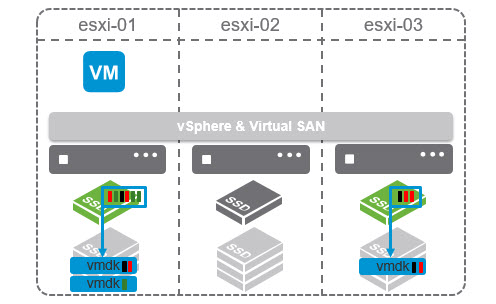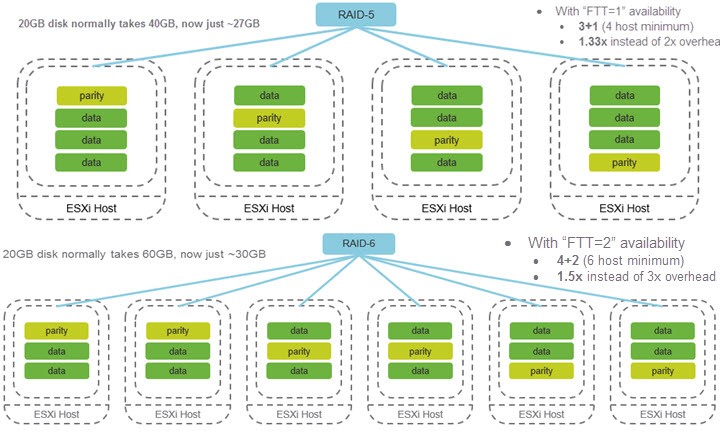Today VMware has released 4th version of VSAN, with version number 6.2. Yes, VMware VSAN 6.2 released today as part of vSphere 6.0 Update 2. It is a major evolution of the product adding features which have been detailed on our blog in this post – VMware VSAN 6.2 Announced – Nearline dedupe, Erasure Coding, QoS ++
Most of the new features targeting the All-Flash version of VSAN which is able to leverage those new saving and protection features without losing performance as the hybrid version (with spinning disks) would get penalized due the fact that the RAID5/RAID6 (erasure coding) increases writes across the cluster.
There are new features in ESXi 6.0 U2 too:
- VMware host client – yes !!! Small vib, now included as a part of the whole ISO, which brings nice and fast HTML 5 client capability for per-host management. It can be used to perform administrative tasks to manage host resources such as virtual machines, networking, and storage. Check my detailed post here. Release notes for v 1.0 here.
- High Ethernet link speed – ESXi 6.0 U2 supports 25 G and 50 G ethernet link speeds
- VAIO Enhancements (vSphere API for I/O Filtering) – ESXi 6.0 Update 2 supports the IO Filter VASA Provider in a pure IPv6 environment. And also VMIOF versions 1.0 and 1.1
vSphere 6.0 Update 2 and VMware VSAN 6.2 – What's new?
vCenter server and ESXi new features
- Two-factor authentication for vSphere Web Client: Protect the vSphere Web Client using the following form of authentication:
- RSA SecurID
- Smart card (That is the UPN based Common Access Card)
- Support to change vSphere ESX Agent Manager logging level: This release supports dynamic increase or decrease of vSphere ESX Agent Manager (EAM) logging levels without restarting EAM.
- vSphere Web Cient support: vSphere Web Client now supports Microsoft Windows 10 OS.
- vCenter Server database support: vCenter Server now supports the following external databases:
- Microsoft SQL Server 2012 Service Pack 3
- Microsoft SQL Server 2014 Service Pack 1
VSAN 6.2 new features
Deduplication – nearline deduplication (not post) and compression per disk group level. (“space efficiency”). Space efficiency enables at the cluster level. The deduplication is done for all the data from the caching tier which goes to the capacity tier with 4k fixed blocks. The same for deduplication below.
Compression – very low CPU utilization. As the data comes to the environment, when they become colder and the data is unique then they’re compressed by used very efficient OV4 LZ4 compression. It’s near-line compression. Only data coming from the write buffer to the capacity tier are touched. The data which are still “hot” aren’t compressed as they’re still modified/updated. The data are compressed after deduplication.

QoS at the VMDK level – very granular possibility to prevent “noisy neighbour” effect, by affecting a limit at the VMDK level. Previously SIOC would help, but with not enough granularity (at the datastore level only).
Better Capacity and Performance Monitoring – the product has built-in monitoring where you can watch the IOPS across your VMs, monitor hosts, latency, throughput, consumption of the capacity layer etc….. More convenient than RVC and VSAN observer.
RAID5/RAID6 Erasure coding – needs 4 (see 6 hosts) minimum, but the RAID 6 can leverage “FTT=2” with only 1.5x overhead (compared to 3x overhead in the previous release). Check the examples in the image below.

New on-disk format – Virtual SAN 6.2 supports upgrades to new on-disk virtual file format 3.0 through the vSphere Web Client. This file system provides support for new features in the Virtual SAN cluster. On-disk format version 3.0 is based on an internal 4K block size technology, which provides improved efficiency, but can result in reduced performance if the guest operating system I/Os are not 4K aligned.
Software checksum and Scrubbing – This is completely new software checksums which will perform the following checks:
- Write failures to disks
- Network copy failures
- Checksum failures – will fetch data from another copy.
- Disk Scrubbing will run in the background
- Enables additional level of data integrity
- Automatically detects and solve silent disk errors
Other Improvements
- Client Cache – write through read memory cache which is “local” to a VM. Data locality to a VM. Brings only very low overhead but has a big impact on performance (especially for VDI). A dynamic memory, taking up to 1Gb from each host. Compared to VSAN 6.1, the client cache will use 4% of host memory up to 1GB of host memory, where other features have their overhead as well. Apparently there is as low as up to 5% more CPU usage than VSAN would use before. So apparently better performance with little more memory consumption per host (1Gb of RAM only).
- Sparse Swap – can reclaim space used by memory swap. It’s an advanced option on a host which enables the setting policy for swap to no space reservation. VMs which are configured with a lot of memory and creating large swap files which consume a lot of space on the VSAN datastore. By specifying an advanced host parameter (yes, it’s and advanced config per host) you can make the swap file thin provisioned. The parameter is ..
/VSAN/SwapThickProvisionDisabled
Download here and Release notes here. Release notes for vCenter server 6.0 U2 are here

not OV4, but LZ4 compression
http://cormachogan.com/2016/02/10/vsan-6-2-an-overview-of-the-new-virtual-san-6-2-features/
Thx. Corrected the post.
how do we update from v 6.0 to v 6.0 U2?
The same way as previously – http://www.vladan.fr/easily-upgrade-esxi-5-x-to-the-latest-esxi-5-5-update-1-via-cli/
Which permissions are needed for a normal user to connect to the html5 console?
I do not want to give them admin rights to the whole thing